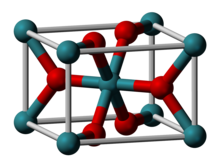This is the current revision of this page, as edited by TerraFrost (talk | contribs) at 03:55, 12 December 2024 (→Aspirational and niche applications: clean up sentence). The present address (URL) is a permanent link to this version.
Revision as of 03:55, 12 December 2024 by TerraFrost (talk | contribs) (→Aspirational and niche applications: clean up sentence)(diff) ← Previous revision | Latest revision (diff) | Newer revision → (diff) | |
| Names | |
|---|---|
| IUPAC name Ruthenium(IV) oxide | |
| Other names Ruthenium dioxide | |
| Identifiers | |
| CAS Number | |
| 3D model (JSmol) | |
| ECHA InfoCard | 100.031.660 |
| EC Number |
|
| PubChem CID | |
| CompTox Dashboard (EPA) | |
InChI
| |
SMILES
| |
| Properties | |
| Chemical formula | RuO2 |
| Molar mass | 133.0688 g/mol |
| Appearance | blue-black solid |
| Density | 6.97 g/cm |
| Boiling point | 1,200 °C (2,190 °F; 1,470 K) sublimates |
| Solubility in water | insoluble |
| Magnetic susceptibility (χ) | +162.0·10 cm/mol |
| Structure | |
| Crystal structure | Rutile (tetragonal), tP6 |
| Space group | P42/mnm, No. 136 |
| Coordination geometry | Octahedral (Ru); trigonal planar (O) |
| Hazards | |
| Flash point | Non-flammable |
| Related compounds | |
| Other anions | Ruthenium disulfide |
| Other cations | Osmium(IV) oxide |
| Related ruthenium oxides | Ruthenium tetroxide |
| Supplementary data page | |
| Ruthenium(IV) oxide (data page) | |
| Except where otherwise noted, data are given for materials in their standard state (at 25 °C , 100 kPa).
| |
Ruthenium(IV) oxide is the inorganic compound with the formula RuO2. This black solid is the most common oxide of ruthenium. It is widely used as an electrocatalyst for producing chlorine, chlorine oxides, and O2. Like many dioxides, RuO2 adopts the rutile structure.
Preparation
It is usually prepared by oxidation of ruthenium trichloride. Nearly stoichiometric single crystals of RuO2 can be obtained by chemical vapor transport, using O2 as the transport agent:
- RuO2 + O2 ⇌ RuO4
Films of RuO2 can be prepared by chemical vapor deposition (CVD) from volatile ruthenium compounds. RuO2 can also be prepared through electroplating from a solution of ruthenium trichloride.
Electrostatically stabilized hydrosols of pristine ruthenium dioxide hydrate have been prepared by exploiting the autocatalytic reduction of ruthenium tetroxide in aqueous solution. The resulting particle populations may be controlled to comprise substantially monodisperse, uniform spheres with diameters in the range 40nm - 160nm.
Uses
Ruthenium(IV) oxide is being used as the main component in the catalyst of the Sumitomo-Deacon process which produces chlorine by the oxidation of hydrogen chloride.
RuO2 can be used as catalyst in many other situations. Noteworthy reactions are the Fischer–Tropsch process, Haber–Bosch process, and various manifestations of fuel cells.
Aspirational and niche applications
RuO2 is extensively used for the coating of titanium anodes for the electrolytic production of chlorine and for the preparation of resistors or integrated circuits. Ruthenium oxide resistors can be used as sensitive thermometers in the temperature range .02 < T < 4 K. It can be also used as active material in supercapacitor because it has very high charge transfer capability. Ruthenium oxide has great capacity to store charge when used in aqueous solutions. Average capacities of ruthenium(IV) oxide have reached 650 F/g when in sulfuric acid and annealed at temperatures lower than 200 °C. In attempts to optimise its capacitive properties, prior work has looked at the hydration, crystallinity and particle size of ruthenium oxide.
References
- Mills, Andrew (1989). "Heterogeneous redox catalysts for oxygen and chlorine evolution". Chemical Society Reviews. 18. Royal Society of Chemistry (RSC): 285. doi:10.1039/cs9891800285. ISSN 0306-0012.
- Wyckoff, R.W.G.. Crystal Structures, Vol. 1. Interscience, John Wiley & Sons: 1963.
- Wells, A. F. (1975), Structural Inorganic Chemistry (4th ed.), Oxford: Clarendon Press
- Schäfer, Harald; Schneidereit, Gerd; Gerhardt, Wilfried (1963). "Zur Chemie der Platinmetalle. RuO2 Chemischer Transport, Eigenschaften, thermischer Zerfall". Zeitschrift für anorganische und allgemeine Chemie (in German). 319 (5–6). Wiley: 327–336. doi:10.1002/zaac.19633190514. ISSN 0044-2313.
- Rogers, D. B.; Butler, S. R.; Shannon, R. D. (1972). "Single Crystals of Transition-Metal Dioxides". Inorganic Syntheses. Vol. XIII. pp. 135–145. doi:10.1002/9780470132449.ch27. ISBN 9780470132449.
- Pizzini, S.; Buzzanca, G.; Mari, C.; Rossi, L.; Torchio, S. (1972). "Preparation, structure and electrical properties of thick ruthenium dioxide films". Materials Research Bulletin. 7 (5). Elsevier BV: 449–462. doi:10.1016/0025-5408(72)90147-x. ISSN 0025-5408.
- Lee, S. (2003). "Electrochromism of amorphous ruthenium oxide thin films". Solid State Ionics. 165 (1–4): 217–221. doi:10.1016/j.ssi.2003.08.035.
- McMurray, H. N. (1993). "Uniform colloids of ruthenium dioxide hydrate evolved by the surface-catalyzed reduction of ruthenium tetroxide". The Journal of Physical Chemistry. 97 (30): 8039–8045. doi:10.1021/j100132a038.
- Vogt, Helmut; Balej, Jan; Bennett, John E.; Wintzer, Peter; Sheikh, Saeed Akbar; Gallone, Patrizio (2000-06-15), "Chlorine Oxides and Chlorine Oxygen Acids", Ullmann's Encyclopedia of Industrial Chemistry, Weinheim, Germany: Wiley-VCH Verlag GmbH & Co. KGaA, doi:10.1002/14356007.a06_483, ISBN 3527306730
- Seki, Kohei (2010-05-29). "Development of RuO2/Rutile-TiO2 Catalyst for Industrial HCl Oxidation Process". Catalysis Surveys from Asia. 14 (3–4). Springer Science and Business Media LLC: 168–175. doi:10.1007/s10563-010-9091-7. ISSN 1571-1013. S2CID 93115959.
- De Nora, O. (1970). "Anwendung maßbeständiger aktivierter Titan-Anoden bei der Chloralkali-Elektrolyse". Chemie Ingenieur Technik. 42 (4). Wiley: 222–226. doi:10.1002/cite.330420417. ISSN 0009-286X.
- Iles, G.S. (1967). "Ruthenium Oxide Glaze Resistors". Platinum Metals Review. 11 (4): 126.
- Matthey, Johnson (2002). "Nanocrystalline Ruthenium Supercapacitor Material". Platinum Metals Review. 46 (3): 105. Archived from the original on 2015-09-24. Retrieved 2013-09-16.
- Kim,Il-Hwan; Kim, Kwang-Bum; Electrochem. Solid-State Lett., 2001, 4, 5,A62-A64
External links
- Los Alamos National Laboratory – Ruthenium Archived 2007-04-05 at the Wayback Machine
| Ruthenium compounds | |
|---|---|
| Ru(0) | |
| Ru(I) | |
| Ru(II) | |
| Ru(II,III) | |
| Ru(III) |
|
| Ru(IV) | |
| Ru(V) | |
| Ru(VI) | |
| Ru(VII) | |
| Ru(VIII) | |